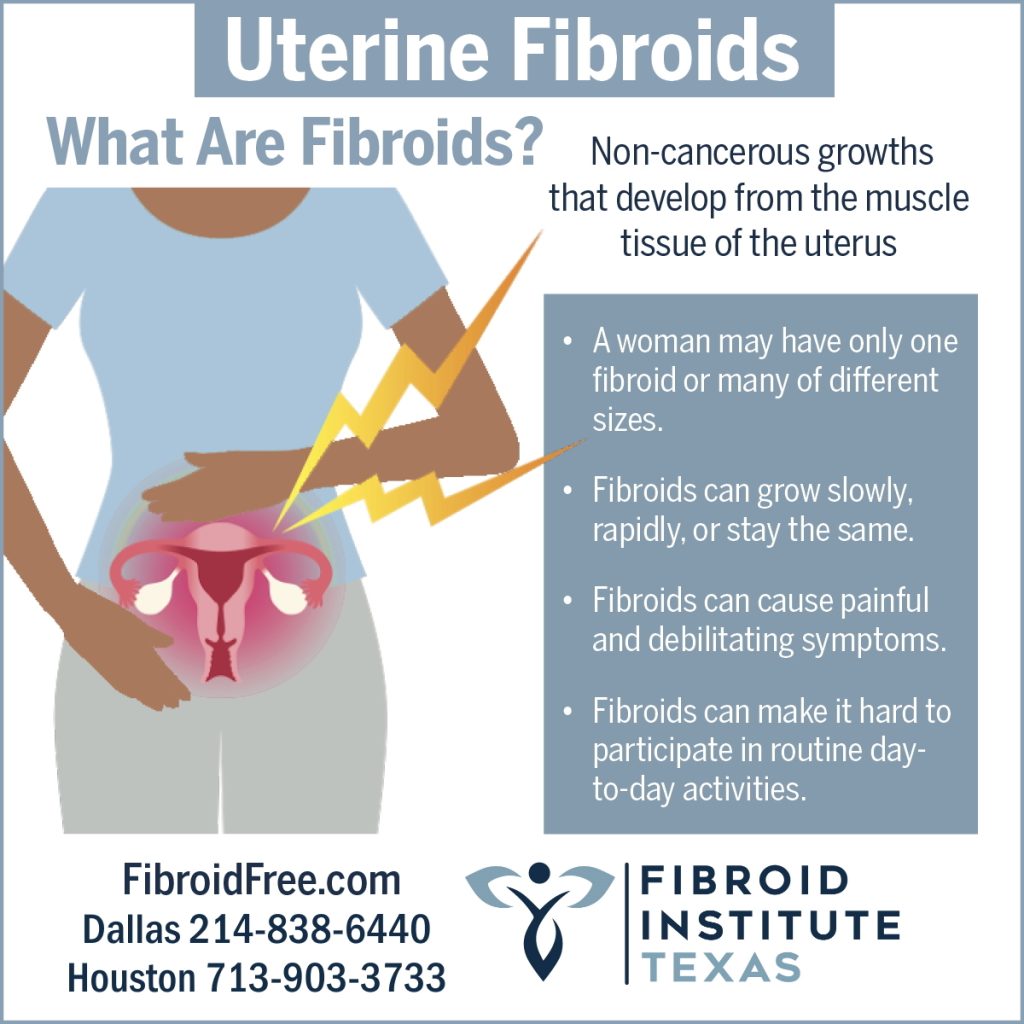When diagnosed with uncomfortable uterine fibroids, many women are told by their doctors that the best, and perhaps only, option for their situation is fibroid removal with surgery. After all, fibroids can worsen if left untreated and removing them sooner rather than later through either a hysterectomy or myomectomy likely means never having to deal with them again. However, while surgery may be the path for some women, others who do not want surgery or are not a viable candidate for surgery often ask if other options exist, which is absolutely the case.
It is important to note that the only way to physically “remove” these non-cancerous tumors is with fibroid surgery. However, innovative non-surgical treatment options such as uterine fibroid embolization (UFE) are equally as effective at providing relief and stopping symptoms—without the need for an invasive and bloody surgery or a lengthy recovery.
Here are a few questions that routinely come up about fibroids and fibroid removal:
15 FAQs About Fibroid Removal
1. What are fibroids, and why do they need to be removed?
Fibroids are non-cancerous growths that develop in or on the uterus. They may need to be removed if they cause ongoing and debilitating symptoms such as heavy menstrual bleeding, pelvic pain and cramping, frequent urination, anemia, or if they interfere with fertility.

2. Do all fibroid cases require treatment or fibroid removal?
No. Some women and their doctors take a wait-and-see approach to their fibroid situation, especially if the patients are not experiencing any symptoms. Treatment is only required in 10-12% of fibroid cases, proving that many fibroid cases do not cause symptoms.
3. What are the different types of fibroid removal procedures?
The main types of fibroid removal procedures include myomectomy (surgical removal of fibroids) and hysterectomy (surgical removal of the uterus).
Unlike surgery which removes fibroids, minimally invasive options such as uterine fibroid embolization (UFE) significantly reduce fibroid symptoms. With UFE an interventional radiologist cuts off the normal blood supply to the fibroid, causing it to shrink and die while eliminating uncomfortable and life-interrupting symptoms.
4. How do I know which fibroid removal procedure is right for me?
The best procedure depends on factors such as the size, number, and location of the fibroids, symptoms, age, desire for future pregnancies, patient recovery needs, and overall health. A fibroid doctor will help determine the most suitable option.
5. What are the risks and complications associated with fibroid removal?
With surgery the risks and complications can vary based on the procedure. These include infection, bleeding, damage to surrounding organs, and potential fertility issues. Minimally invasive procedures tend to have fewer complications.
6. How long is the recovery time after fibroid removal?
Recovery time depends on the type of procedure. Minimally invasive procedures like UFE or laparoscopic myomectomy may have a shorter recovery period (a few days to a couple of weeks), while traditional surgery like a hysterectomy may require several weeks.

7. Will removing fibroids affect my fertility?
It depends on the type of procedure and the extent of fibroid removal. Myomectomy can improve fertility in many cases, but a hysterectomy results in fertility loss. Discussing your reproductive plans with your OB-GYN or fibroid doctor is essential.
8. Are there non-surgical options for treating fibroids?
Yes. Non-surgical options include medication to control symptoms, hormone therapy, Acessa, Sonata, and uterine fibroid embolization (UFE). Here are more details on each:
- Medications — Medications primarily focus on managing symptoms like heavy menstrual bleeding and pain. Nonsteroidal anti-inflammatory drugs (NSAIDs) can help reduce pain, while oral contraceptives or progestins regulate menstrual cycles and lessen bleeding. These medications don’t shrink the fibroids but provide symptom relief.
- Hormone therapy — This treatment regulates the levels of hormones like estrogen and progesterone, which can shrink the fibroids or reduce their growth. Medications such as gonadotropin-releasing hormone (GnRH) agonists temporarily lower estrogen levels, causing fibroids to shrink and alleviating symptoms like heavy bleeding. However, hormone therapy is usually a temporary solution and doesn’t remove the fibroids entirely.
- Acessa — In this procedure, a small probe is placed into a fibroid and heated up to destroy it. If you have multiple large fibroids or fibroids that are hard to get to, Acessa is not a good choice. It is also not covered by some insurance companies.
- Sonata System — Radiofrequency energy shrinks fibroids using an intrauterine ultrasound device. Sonata works well when the patient has one or several fibroids and/or non-pedunculated submucosal fibroids. Fibroids larger than 5.0 cm may require multiple ablations.
- Endometrial Ablation — This technique removes the inside lining of the uterus to reduce heavy bleeding. Doctors place a thin instrument into the uterus through the cervix and use heat, laser, electricity, microwaves, or freezing. However, it is not a good option if you want to get pregnant in the future. It also will not shrink or treat fibroids outside the interior uterine lining.
- Uterine Fibroid Embolization (UFE) — This is a minimally invasive procedure that cuts off blood flow to fibroids, causing them to shrink and die. UFE is provided by a specialized fibroid doctor known as an interventional radiologist. UFE is safer, non-surgical, and offers a faster recovery time than its predecessors. It is low risk, does not require incisions, and can be completed in a fibroid clinic or office as opposed to requiring a costly hospital stay. For patient life quality, important benefits of undergoing UFE are relief from symptoms associated with fibroids, like heavy menstrual bleeding, depleted energy, and being homebound during your menstrual cycle.
9. Can UFE prevent a hysterectomy?
Yes, it may substantially reduce the need for one. Fibroids are the leading cause of hysterectomies in the United States, accounting for 39% of all hysterectomies performed yearly.
10. Can I have UFE if I still want to get pregnant?
It is possible to have a normal pregnancy, a normal delivery, and a normal baby after having the procedure. However, there is a small amount of evidence that suggests a slightly higher miscarriage rate if you have UFE. If given the option to have another treatment for your fibroids, that may be safer until further data is available about pregnancy after UFE. If a woman has been told that hysterectomy is her only treatment option, we would be happy to discuss the possibility of UFE with her.
11. What if I feel nervous before my UFE procedure?
If you choose Fibroid Institute Texas, a mild sedative is given an hour before the procedure to help you relax. This helps ease nerves considerably.

12. How do I prepare for my UFE procedure?
If you choose Fibroid Institute Texas, your fibroid treatment team will explain what the instructions are before the procedure, and we will provide you with written instructions.
13. What can I expect during the recovery period with UFE?
Recovery experiences vary, but you may initially experience pain, discomfort, and limited mobility. It is essential to follow post-procedure care instructions, which may include rest, avoiding heavy lifting, and gradually returning to normal activities. If you choose Fibroid Institute Texas, we have developed a unique pain management protocol. As a result, our patients report little to no pain when they follow our recommendations.
14. Will fibroids come back after removal?
Fibroids can recur. The likelihood depends on the procedure, the patient’s age, and hormonal factors. That said, UFE has a 90% success rate.
15. What lifestyle changes can help manage or prevent fibroids?
Maintaining a healthy weight, eating a balanced diet of fruits and vegetables, managing stress, and regular exercise may help manage or reduce the risk of fibroids. Reducing red meat and alcohol consumption, which are linked to higher fibroid risk, can be beneficial. Regular check-ups with your healthcare provider are also important.

100% Fibroid-Focused Practice: Experience Matters
Whether you intend to have fibroid removal surgery or are looking for alternatives, it is important to be as educated as possible about what options are available to you and your unique needs, including Dallas fibroid removal surgery and who can step in as the provider for your situation. As board-certified interventional radiologists our Houston and Dallas fibroid doctors help thousands of women avoid fibroid surgery and find relief from their fibroid symptoms. Our team is always on hand to partner with you and your doctor to determine the best course of action for you.
At Fibroid Institute, we do not believe you need to decide between suffering in silence and having invasive surgery. That is why we are dedicated to treating fibroids using uterine fibroid embolization (UFE), the gold standard in non-surgical fibroid treatment. With multiple locations, our Dallas and Houston fibroid clinics help thousands of women avoid fibroid surgery and find relief from their fibroid symptoms.
Request a free 10-15-minute phone screening to determine if you are a candidate. If you qualify for UFE after the screening, you can schedule your on-site or telehealth consultation at our 100% fibroid-focused practice. Most major medical insurance providers cover the cost of UFE.
Get started now with Fibroid Institute Dallas at 214-838-6440 or with Fibroid Institute Houston at 713-903-3733 or complete the form below. We are dedicated to helping you become #FibroidFree.
Fibroid Institute Texas serves the Dallas and Houston areas including Texas City, Cypress, League City, Bellaire, Addison, Carrollton, Plano, Frisco, Craig Ranch, McKinney, Allen, Fort Worth, Grand Prairie, HEB, Arlington, Euless, Hutchins, Irving, Duncanville, DeSoto, Cedar Hill, Lancaster, Cockrell Hill, Highland Park, University Park, Park Cities, Garland, Mesquite, Richardson, Dallas, Sherman, Houston, Sugar Land, Katy, Webster, Clear Lake, The Woodlands, Universal City, Spring, Kingwood, Stafford, Conroe, and more.
Before starting any new treatment or if you have questions regarding a medical condition, always seek the advice of your doctor or other qualified health provider. This information is not a substitute for professional medical advice.
*Patient names and/or photos may be changed to protect patient confidentiality.

